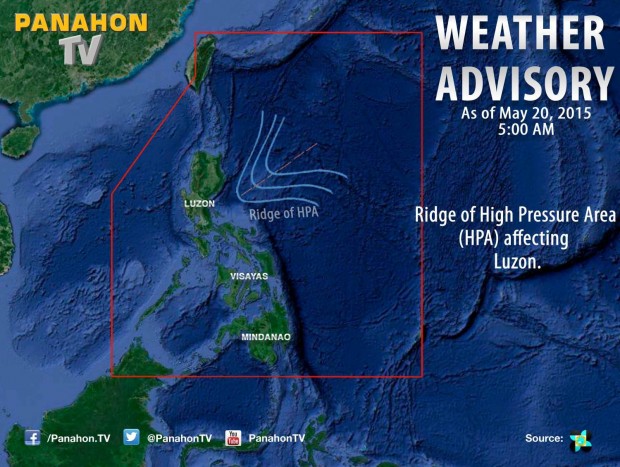Home > Blog > Weather Today
Weather Today – May 20, 2015 | PH still “Bagyo-free”

Still good news today as there is no weather disturbance monitored outside the Philippine Area of Responsibility (PAR). Even Dolphin continues to move farther,l no longer threatening the country. PAGASA Weather Forecaster Meno Mendoza said the Philippines will remain “bagyo-free” within the next three days. However, all are still advised to monitor updates from the weather bureau.
The ridge or the extended part of high pressure area (HPA) prevails over the PAR, extending over Luzon. Generally fair weather will be experienced over the whole archipelago aside from the isolated thunderstorms in the afternoon or evening.
Today, temperatures are as high as what we have experienced yesterday. The highest range will be in Metro Manila with 26 to 35 degrees Celsius. In Metro Cebu, temperature could rise up to 33 degrees Celsius while Metro Davao can expect 26 to 33 degrees Celsius.
However, the heat index is much higher than the actual air temperature. Heat index indicates how warm the body feels when the air temperature and the relative humidity are combined. People in Metro Manila must brace for a blazing 39.9 degrees Celsius heat index. Metro Cebu has 38.8 degrees Celsius while Metro Davao can expect 38.5 degrees Celsius.
NASA: Ozone hole continues to shrink
Based on the latest study from the National Aeronautics and Space Administration (NASA), the ozone hole is decreasing in size. The ozone is a gas made up of three oxygen atoms which naturally occurs in small amounts in the upper atmosphere or the stratosphere.
Ozone protects life on Earth from the ultraviolet radiation from the Sun. In the atmosphere near the Earth’s surface, ozone is created by chemical reactions between air pollutants. At the ground level, high concentrations of ozone are toxic to people and plants.
Mendoza said the ozone hole has gotten smaller due to the absence or lack of chlorine, changes in temperature and wind patterns. NASA said this ozone hole could become smaller in 2040 and will completely disappear by 2100.




